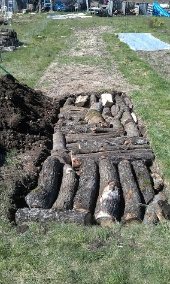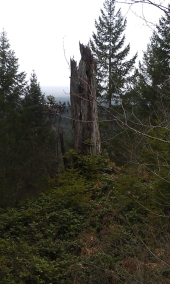
 1
1




 1
1




Permaculture and Homestead Blogging on the Traditional Catholic Homestead in Idaho! Jump to popular topics here: Propagating Morels!, Continuous Brew Kombucha!, and The Perfect Homestead Cow!

 1
1




Ven Wood wrote:Hi. Pleased to meet everyone involved in this wonderful website.
I live in Springfield, MO, and am working on a proposal with two friends to get a few abandoned lots from the city to use as food forest space. We are trying to find information on how burying wood can increase the carbon sequestration and/or tie up carbon in the soil. Basically, we need someone to help us with explaining the science behind how hugelkulturs within a perennial food forest system can be a benefit to the environment, and specifically how burying wood can help. The reason we are focusing on (sunken) hugelkultur beds is that we are currently taking tree waste from local trimmers and using it in gardens instead of allowing it to sit in compost piles or be burned. We want to take more and put more tree waste, as much as possible into the soil, on a bigger scale, and we want to convince the city that it's a good idea to have these perennial polycultures instead of the alternatives of burning and composting. If anyone can help, we don't need a lot of ongoing support. Just enlighten us uneducated yet impassioned people!
Also, with the idea of a food forest in mind, and with 10,000 square feet per lot to work with for planting, while using sunken hugelkulturs, with access to unlimited wood and chips and brush, a backhoe, and a bobcat, where would you look in order to make the best decisions for design? Thank you so much for the help.
Ven
List of Bryant RedHawk's Epic Soil Series Threads We love visitors, that's why we live in a secluded cabin deep in the woods. "Buzzard's Roost (Asnikiye Heca) Farm." Promoting permaculture to save our planet.
 1
1




Idle dreamer
 1
1




 1
1




Idle dreamer
 2
2




Tyler Ludens wrote:I've used my weak math skills to calculate that one cord of mixed hardwood and softwood, buried, can sequester 2.5 tons of CO2. Can someone else check this using the calculations here? http://www.forestry.state.al.us/HowMuchCarbonHaveYourTreesStored.aspx?bv=5&s=0
 2
2




Tyler Ludens wrote: This winter I'll be helping my husband with a massive hugelkultur-like project of building brush dams aka leaky weirs in our creek to de-energize flood waters. The creek is cut into a channel 4 - 5 feet deep, and we plan to cram this full of wood for maybe 30 feet initially. That will probably be a couple tons of wood.
 1
1




john mcginnis wrote:
Does that creek run off your property into some elses land? If so, are you prepared for the liability when that wood decides to up and move?
Idle dreamer
 1
1




john mcginnis wrote:
Hate to point out the obvious, but the carbon sequestration occurred when the tree sprouted from seed, grew and became that mighty tree.
Idle dreamer
 1
1




 1
1




Idle dreamer
 1
1





Idle dreamer

 1
1




"Never doubt that a small group of thoughtful, committed citizens can change the world; indeed, it's the only thing that ever has."-Margaret Mead "The only thing worse than being blind, is having sight but no vision."-Helen Keller
 1
1




Idle dreamer










 1
1




"Never doubt that a small group of thoughtful, committed citizens can change the world; indeed, it's the only thing that ever has."-Margaret Mead "The only thing worse than being blind, is having sight but no vision."-Helen Keller
 1
1




Idle dreamer










 1
1







"Never doubt that a small group of thoughtful, committed citizens can change the world; indeed, it's the only thing that ever has."-Margaret Mead "The only thing worse than being blind, is having sight but no vision."-Helen Keller










 1
1




 lucky number, that.
lucky number, that. 
"Never doubt that a small group of thoughtful, committed citizens can change the world; indeed, it's the only thing that ever has."-Margaret Mead "The only thing worse than being blind, is having sight but no vision."-Helen Keller





 1
1




Permaculture and Homestead Blogging on the Traditional Catholic Homestead in Idaho! Jump to popular topics here: Propagating Morels!, Continuous Brew Kombucha!, and The Perfect Homestead Cow!
 2
2




Dave Dahlsrud wrote: It seems as though you could extrapolate that line of thinking to include buried wood in the same category as rotting root masses that go into creating the humus content of our soils.... hugelkutur creates humus rich soils as the wood core breaks down. Anecdotal evidence from the likes of Sepp Holzer indicate that once the wood core has fully decomposed and the mound is broken down to be rebuilt you are left with the finest, humus rich soil you can imagine to create new growing areas from. Holzer has been utilizing hugelkultur for this for decades with excellent success.
 : https://permies.com/forums/f-190/biochar
: https://permies.com/forums/f-190/biocharIdle dreamer










 1
1




 and I was, perhaps focusing more on the underlined part of quote 5 (since the wood material in a hugulkultur is certainly biomass) to understand quote 6. While not trying to take away from the benefit of your extrapolation, which I think is valuable and has merit, Dave D, as far as this, or any other theoretical topic of conversation, a person can extrapolate in many different directions but gain little on the hypothesis without a controlled experiment. That said, my own extrapolations and conclusions are in the same boat.
and I was, perhaps focusing more on the underlined part of quote 5 (since the wood material in a hugulkultur is certainly biomass) to understand quote 6. While not trying to take away from the benefit of your extrapolation, which I think is valuable and has merit, Dave D, as far as this, or any other theoretical topic of conversation, a person can extrapolate in many different directions but gain little on the hypothesis without a controlled experiment. That said, my own extrapolations and conclusions are in the same boat.

"Never doubt that a small group of thoughtful, committed citizens can change the world; indeed, it's the only thing that ever has."-Margaret Mead "The only thing worse than being blind, is having sight but no vision."-Helen Keller
 1
1




Roberto pokachinni wrote: breaking up the hugulkultur to rebuild it
Idle dreamer










 1
1




Breaking up a hugelkultur to rebuild it seems a bizarre idea to me and I don't know why anyone would do that rather than simply add more material to it (or, perhaps better, leave it alone and grow trees on or next to it).

 Also, the first link might help me to convince the local community forest to not burn slash, but to lay it on the surface, or better yet try hugulkulturing it.
Also, the first link might help me to convince the local community forest to not burn slash, but to lay it on the surface, or better yet try hugulkulturing it."Never doubt that a small group of thoughtful, committed citizens can change the world; indeed, it's the only thing that ever has."-Margaret Mead "The only thing worse than being blind, is having sight but no vision."-Helen Keller
 1
1





Idle dreamer










 1
1




"Never doubt that a small group of thoughtful, committed citizens can change the world; indeed, it's the only thing that ever has."-Margaret Mead "The only thing worse than being blind, is having sight but no vision."-Helen Keller
 1
1





Idle dreamer
 3
3




"Permaculture is a philosophy of working with, rather than against nature; of protracted & thoughtful observation rather than protracted & thoughtless labour; & of looking at plants & animals in all their functions, rather than treating any area as a single-product system."-Bill Mollison


















While, in your view, the carbon sequestration question may have no bearing on the project, Ven was looking for data or facts, or ideas pertaining to this in order to convince bureaucrats. That seemed to be the quest that Ven was on, and I think that that is what was explored in the discussion, if I remember correctly, and via a brief skim seems to be accurate; though I'm not now going to read the entire thread's contents again at the moment, I think that you will find that that is the case. I think that there was a great deal more than the suggestion for Ven to experiment in this thread, and there was quite a discussion about carbon sequestration.We are trying to find information on how burying wood can increase the carbon sequestration and/or tie up carbon in the soil. Basically, we need someone to help us with explaining the science behind how hugelkulturs within a perennial food forest system can be a benefit to the environment, and specifically how burying wood can help.

"Never doubt that a small group of thoughtful, committed citizens can change the world; indeed, it's the only thing that ever has."-Margaret Mead "The only thing worse than being blind, is having sight but no vision."-Helen Keller








This is all just my opinion based on a flawed memory










|
So you made a portal in time and started grabbing people. This tiny ad thinks that's rude:
The new purple deck of permaculture playing cards
https://www.kickstarter.com/projects/paulwheaton/garden-cards
|






